Topics 2006
December 2006
Dec. 27, 2006 Updated
KIKU No. 8 completes LDR deployment moving to the Initial Functional Verification Phase
|
The KIKU No. 8 (ETS-VIII), which was injected into the drift orbit after four rounds of apogee engine firing, started to deploy the receiving antenna of its large deployable antenna reflector (LDR) at 5:31p.m. on Dec. 25 and the sending antenna at 6:56 p.m. on Dec. 26. Both these antennas were confirmed to be successfully deployed through telemetry data and images from onboard cameras sent from the satellite on the respective days. At 4:14 a.m. on the 27th, the attitude control mode was shifted to the regular control mode to advance to the initial functional verification phase. 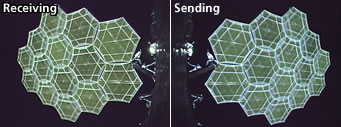
|
December 26, 2006 Updated
More celebrities participating in the SELENE
 The "SELENE" is a lunar orbiter scheduled to be launched in the Summer of 2007. JAXA is carrying out a campaign to collect the names and messages to send them to the Moon on the "SELENE." In addition to Mr. Masahiro Kawai, coach of the pro baseball team Chunichi Dragons, more and more celebrities are becoming interested in the campaign. Mr. Hiroshi Aoshima, a composer and pianist, Mr. Yoshiyuki Tatsumi of the Japan Agency for Marine-Earth Science and Technology, JAMSTEC, and Sakana-Kun (or Mr. Fish who is famous for his abundant knowledge of fish) are participating in the campaign.
The "SELENE" is a lunar orbiter scheduled to be launched in the Summer of 2007. JAXA is carrying out a campaign to collect the names and messages to send them to the Moon on the "SELENE." In addition to Mr. Masahiro Kawai, coach of the pro baseball team Chunichi Dragons, more and more celebrities are becoming interested in the campaign. Mr. Hiroshi Aoshima, a composer and pianist, Mr. Yoshiyuki Tatsumi of the Japan Agency for Marine-Earth Science and Technology, JAMSTEC, and Sakana-Kun (or Mr. Fish who is famous for his abundant knowledge of fish) are participating in the campaign.
Sakana-Kun gave us a very pleasant comment, "Wow! Amazing! It is really romantic! Can I register the names of fish?"
We are accepting names and messages until Jan. 31 through the Internet or by postcard.
December 21, 2006 Updated
SELENE
 The "SELENE" is a lunar orbiter scheduled to be launched in the Summer of 2007. JAXA is carrying out a campaign to collect names and messages to send them to the Moon on the "SELENE."
The "SELENE" is a lunar orbiter scheduled to be launched in the Summer of 2007. JAXA is carrying out a campaign to collect names and messages to send them to the Moon on the "SELENE."
On Dec. 15, Mr. Masahiro Kawai, coach for the pro baseball team Chunichi Dragons, visited JAXA i for this campaign. We are looking forward to receiving many heartful messages.
We are accepting names and messages until Jan. 31 through the Internet or by postcard.
December 21, 2006 Updated
KIKU No. 8 currently flying on its transfer orbit
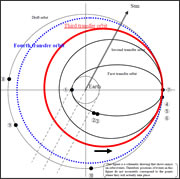 The KIKU No. 8 launched by the H-IIA Launch Vehicle No. 11 at 3:32 p.m. on December 18, 2006 (Japan Standard Time) has successfully deployed its solar array paddles and is now flying on its transfer orbit. The satellite is firing its apogee engine to inject itself to the drift orbit. For the latest information about the KIKU No. 8, please read our Special Site.
The KIKU No. 8 launched by the H-IIA Launch Vehicle No. 11 at 3:32 p.m. on December 18, 2006 (Japan Standard Time) has successfully deployed its solar array paddles and is now flying on its transfer orbit. The satellite is firing its apogee engine to inject itself to the drift orbit. For the latest information about the KIKU No. 8, please read our Special Site.
December 18, 2006 Updated
KIKU No. 8 deployed solar array paddles
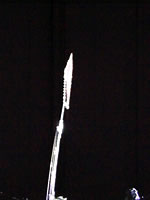 The Japan Aerospace Exploration Agency (JAXA) received signals from "KIKU No. 8" at the Santiago Station in Chile and the Maspalomas Station in the Canary Islands (the Kingdom of Spain). Through the received signals and images, we have confirmed that solar array paddles have been deployed and sun acquisition was successfully performed.
The Japan Aerospace Exploration Agency (JAXA) received signals from "KIKU No. 8" at the Santiago Station in Chile and the Maspalomas Station in the Canary Islands (the Kingdom of Spain). Through the received signals and images, we have confirmed that solar array paddles have been deployed and sun acquisition was successfully performed.
The "KIKU No. 8" was launched from the Tanegashima Space Center at 3:32 p.m. on December 18, 2006, Japan Standard Time (JST.) The satellite is now in good condition, and operations are progressing smoothly.
December 18, 2006 Updated
KIKU No. 8/H-IIA F11 successful launch and payload injection
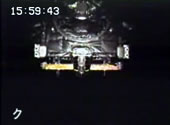 The H-IIA Launch Vehicle No. 11 (H-IIA F11) with the Engineering Test Satellite VIII "KIKU No. 8" (ETS-VIII) onboard was launched at 3:32 p.m. on December 18, 2006 (Japan Standard Time, JST.) The launch vehicle flew smoothly, and, at about 28 minutes after liftoff, the "KIKU No. 8" separation was confirmed.
The H-IIA Launch Vehicle No. 11 (H-IIA F11) with the Engineering Test Satellite VIII "KIKU No. 8" (ETS-VIII) onboard was launched at 3:32 p.m. on December 18, 2006 (Japan Standard Time, JST.) The launch vehicle flew smoothly, and, at about 28 minutes after liftoff, the "KIKU No. 8" separation was confirmed.
We would like to express our profound appreciation for the cooperation and support of all related personnel and organizations that helped contribute to the successful launch of the H-IIA F11.
December 18, 2006 Updated
We are now ready for launch!
 The launch countdown has started for the KIKU No. 8/ H-IIA F11 in Tanegashima. The scheduled launch time is 3:32 p.m. The preparation status is being updated under the "Countdown Report" in the special site for the launch. The live launch report will start at 2:30 p.m. You can enjoy the report through the Internet, at some JAXA broadcast sites, on big screens on the streets, in science museums, and via cable TV.
The launch countdown has started for the KIKU No. 8/ H-IIA F11 in Tanegashima. The scheduled launch time is 3:32 p.m. The preparation status is being updated under the "Countdown Report" in the special site for the launch. The live launch report will start at 2:30 p.m. You can enjoy the report through the Internet, at some JAXA broadcast sites, on big screens on the streets, in science museums, and via cable TV.
December 16, 2006 Updated
Launch postponement of the KIKU No. 8/H-IIA F11
The launch of the KIKU No. 8/H-IIA F11 scheduled on Dec. 16 has been postponed due to clouds including a freezing layer observed above the launch site. There is little possibility for the weather to recover by the time of the launch.
The new launch date has been set for December 18 (Mon), 2006 (Japan Standard Time, JST). The scheduled launch time is between 3:32 thru 3:44 p.m. (JST.)
December 15, 2006 Updated
Live launch broadcast
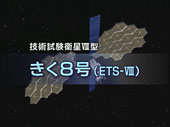 The KIKU No. 8 (ETS-VIII) and H-IIA F11 are ready for tomorrow's launch. JAXA will broadcast the launch live from the studio in Tanegashima with comments and explanations by JAXA employees.
The KIKU No. 8 (ETS-VIII) and H-IIA F11 are ready for tomorrow's launch. JAXA will broadcast the launch live from the studio in Tanegashima with comments and explanations by JAXA employees.
The live broadcast will be provided in various ways, namely through the Internet, at special broadcast sites, on big screens on streets, in science museums, and on Cable TV, for as many people as possible to enjoy it. The broadcast is scheduled to start at 2:30 p.m.
*The broadcast time schedule is subject to change due to the operation status, weather conditions and other factors on the launch day.
December 11, 2006 Updated
KIKU No. 8 onboard the H-IIA
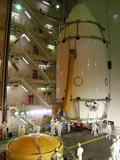 Launch preparation operations are underway for the KIKU No. 8 at the Tanegashima Space Center.
Launch preparation operations are underway for the KIKU No. 8 at the Tanegashima Space Center.
After the mating with the PAF at the SFA, the satellite was encapsulated with the fairing, and loaded onto the launch vehicle. The KIKU No. 8 is now ready for the countdown. Its condition will be monitored and maintained by remote equipment until launch.
December 8, 2006 Updated
Encapsulated KIKU No. 8 moved to the VAB Countdown to launch
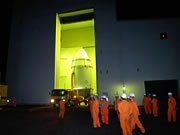 The "KIKU No. 8 (ETS-VIII)," which had been encapsulated by fairing at the Spacecraft and Fairing Assembly Building (SFA), left the SFA for the Vehicle Assembly Building (VAB) on the night of Dec. 7. The transportation went smoothly. In the VAB, the encapsulated KIKU No. 8 will be loaded onto the launch vehicle to be ready for the coming launch.
The "KIKU No. 8 (ETS-VIII)," which had been encapsulated by fairing at the Spacecraft and Fairing Assembly Building (SFA), left the SFA for the Vehicle Assembly Building (VAB) on the night of Dec. 7. The transportation went smoothly. In the VAB, the encapsulated KIKU No. 8 will be loaded onto the launch vehicle to be ready for the coming launch.
December 1, 2006 Updated
SELENE "WISH UPON THE MOON" Campaign
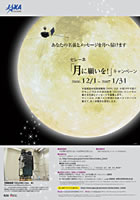 JAXA invites you to send your name and message to be delivered to the Moon. The campaign aims to make people feel more familiar with the Selenological and Engineering Explorer (or Moon explorer) "SELENE" project. Your names and messages will be delivered to the Moon on the "SELENE."
JAXA invites you to send your name and message to be delivered to the Moon. The campaign aims to make people feel more familiar with the Selenological and Engineering Explorer (or Moon explorer) "SELENE" project. Your names and messages will be delivered to the Moon on the "SELENE."
This is a worldwide campaign in cooperation with The Planetary Society of Japan and The Planetary Society of the U.S.A.
We can accept names and messages until January 31, 2007. We are looking forward to many entries.
November 2006
November 29, 2006 Updated
Japanese Experiment Module "Kibo" open to the press
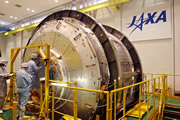 On the On Nov. 28, the Experiment Logistics Module Pressurized Section and the Remote Manipulator System (Robotic Arm) of the Japanese Experimental Module (JEM) "Kibo" were open to the press at the Tsukuba Space Center. The Kibo is part of the International Space Station (ISS.)
On the On Nov. 28, the Experiment Logistics Module Pressurized Section and the Remote Manipulator System (Robotic Arm) of the Japanese Experimental Module (JEM) "Kibo" were open to the press at the Tsukuba Space Center. The Kibo is part of the International Space Station (ISS.)
The Kibo is Japan's first manned space facility where astronauts can carry out activities for a long time. Up to four astronauts can be onboard the Kibo. The Kibo will be transported to the ISS by three Space Shuttle flights between 2007 and 2008.
The Experiment Logistic Module Pressurized Section and the Robotic Arm will be prepared for shipping to NASA's Kennedy Space Center in the U.S. to be ready for the launch.
November 14, 2006 Updated
Preparations for launch of KIKU No. 8 (ETS-VIII) and H-IIA F11 running smoothly
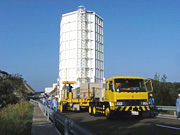 On the morning of Nov. 2 at the Tanegashima Space Center (TNSC), the "KIKU No. 8 (ETS-VIII)" completed its post-transportation function verification, and was moved from the Spacecraft and Fairing Assembly Building No. 2 (SFA2) to the Spacecraft and Fairing Assembly Building (SFA) for final preparations.
On the morning of Nov. 2 at the Tanegashima Space Center (TNSC), the "KIKU No. 8 (ETS-VIII)" completed its post-transportation function verification, and was moved from the Spacecraft and Fairing Assembly Building No. 2 (SFA2) to the Spacecraft and Fairing Assembly Building (SFA) for final preparations.
On the ninth, the cryogenic test for the H-IIA Launch Vehicle Flight No.11 (H-IIA F11) was held at the TNSC.
Preparations for the payload and launch vehicle are running smoothly ahead of the launch scheduled for next month.
November 9, 2006 Updated
Mercury Transit across the Sun as Observed with
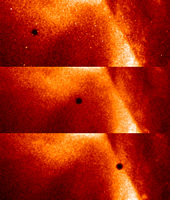 The Mercury transit event across the Sun that took place in the morning of 9 November 2006 JST was successfully observed in great detail with the three telescope instruments aboard Hinode satellite. Panels below show images from Hinode for the episode around the contact of Marcury to the solar disk (i.e., around first and second contacts).
The Mercury transit event across the Sun that took place in the morning of 9 November 2006 JST was successfully observed in great detail with the three telescope instruments aboard Hinode satellite. Panels below show images from Hinode for the episode around the contact of Marcury to the solar disk (i.e., around first and second contacts).
Each telescope is at this moment still under the stage of continuous adjustment and optimization after the launch to achieve its best-possible performance on orbit. Hence it should be noted the images presented here are not necessarily taken with the highest optical performance the relevant telescope would exhibit. Further improvement of image quality would be expected as the adjustment progresses.
All the telescope instruments aboard Hinode have so far been successfully performing their initial engineering observations. Mercury transit data acquired this time will be helpful for the adjustment of telescope optics as well as calibrating alignment information of the instruments.
November 6, 2006 Updated
KIKU No.8 (ETS-VIII?open to the press
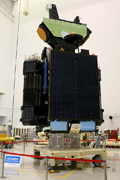 The Engineering Test Satellite "KIKU No. 8 (ETS-VIII), which arrived at the Tanegashima Space Center in September, was open to the press on Nov. 1, and the satellite showed its body wrapped in black insulation material with its stowed antennas and solar array paddles. Launch preparations are proceeding smoothly.
The Engineering Test Satellite "KIKU No. 8 (ETS-VIII), which arrived at the Tanegashima Space Center in September, was open to the press on Nov. 1, and the satellite showed its body wrapped in black insulation material with its stowed antennas and solar array paddles. Launch preparations are proceeding smoothly.
October 2006
October 31, 2006 Updated
Protective doors of the telescopes onboard
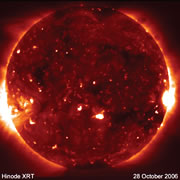 The sun-observing satellite "Hinode (SOLAR-B)," launched on Sep. 23, 2006, (JST) by the M-V Launch Vehicle No. 7 from the Uchinoura Space Center, has completed its major initial operations including orbit adjustment to a sun-synchronous orbit and performance verification of the attitude control function. The protective doors of all three onboard telescopes have now been opened. The satellite started observing the sun in order to verify the performance of the three telescopes. For about the next month, observation activities will progress until they reach the implementation of a scientific operation mode.
The sun-observing satellite "Hinode (SOLAR-B)," launched on Sep. 23, 2006, (JST) by the M-V Launch Vehicle No. 7 from the Uchinoura Space Center, has completed its major initial operations including orbit adjustment to a sun-synchronous orbit and performance verification of the attitude control function. The protective doors of all three onboard telescopes have now been opened. The satellite started observing the sun in order to verify the performance of the three telescopes. For about the next month, observation activities will progress until they reach the implementation of a scientific operation mode.
October 30, 2006 Updated
"KIKU No. 8," a final spurt ahead of launch
 Various activities are underway ahead of the launch of the "KIKU No. 8" including announcements about the launch day, its nickname, and its symbol character "KIKU Hachi-zo."
Various activities are underway ahead of the launch of the "KIKU No. 8" including announcements about the launch day, its nickname, and its symbol character "KIKU Hachi-zo."
The "KIKU No. 8 (ETS-VIII)," which had been delivered to the TNSC, was unpacked and reassembled, and a final functional verification test was carried out.
As the final preparation for launch, the "KIKU No. 8" will be loaded with propellant, installed with pyrotechnics, and placed on the launch vehicle.
October 27, 2006 Updated
Launch day is set! Special site is open!
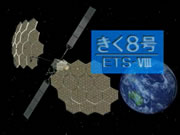 The launch day of the Engineering Test Satellite VIII "KIKU No. 8 (ETS-VIII)" is set for December 16, 2006. We have opened a special site to provide you with the latest information about "KIKU No. 8 (ETS-VIII)" and H-IIA Launch Vehicle No. 11 (H-IIA No.11.) Please enjoy this site.
The launch day of the Engineering Test Satellite VIII "KIKU No. 8 (ETS-VIII)" is set for December 16, 2006. We have opened a special site to provide you with the latest information about "KIKU No. 8 (ETS-VIII)" and H-IIA Launch Vehicle No. 11 (H-IIA No.11.) Please enjoy this site.
October 23, 2006 Updated
Engineering Test Satellite VIII (ETS-VIII) nicknamed
 The Engineering Test Satellite VIII (ETS-VIII) was nicknamed "KIKU No.8" ("KIKU" means "chrysanthemum" in English.) The ETS series has been named "KIKU" since its first satellite.
The Engineering Test Satellite VIII (ETS-VIII) was nicknamed "KIKU No.8" ("KIKU" means "chrysanthemum" in English.) The ETS series has been named "KIKU" since its first satellite.
The catchphrase for the "KIKU No. 8" is:
Opening the door to the future by deploying big antennas and providing security
-- Large-size satellite opens up new mobile phone communication world --
JAXA has been conducting the ETS series project with the aim of achieving satellite technology that can meet the needs of the future.
"KIKU No. 8," or the 8th ETS, will challenge technological standards in communications and positioning that can make our life more convenient and comfortable.
The ETS-VIII symbol character "KIKU Hachi-zo" was born to help the public feel closer to the satellite. We hope you like both the satellite and the mascot.
October 16, 2006 Updated
Lunar exploration satellite "SELENE" make its appearance
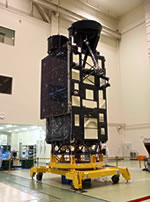 On Oct. 13, the lunar exploration satellite, Selenological Engineering Explorer (SELENE), introduced itself to the public at the Tsukuba Space Center. The SELENE is 2.1 meters both in length and width, 4.8 meters in height, and three tons in weight including its two sub-satellites (each of which is about 50 kg.) The satellite is scheduled to be launched by an H-IIA launch vehicle from the Tanegashima Space Center in the summer of next year. It then will circulate on a lunar orbit 100 km above the moon for a year to elucidate the mystery of the lunar origin and development by observing the distribution of elements and minerals on the surface of the moon, its geographical features, surface structure, and gravity and magnetic fields in details.
On Oct. 13, the lunar exploration satellite, Selenological Engineering Explorer (SELENE), introduced itself to the public at the Tsukuba Space Center. The SELENE is 2.1 meters both in length and width, 4.8 meters in height, and three tons in weight including its two sub-satellites (each of which is about 50 kg.) The satellite is scheduled to be launched by an H-IIA launch vehicle from the Tanegashima Space Center in the summer of next year. It then will circulate on a lunar orbit 100 km above the moon for a year to elucidate the mystery of the lunar origin and development by observing the distribution of elements and minerals on the surface of the moon, its geographical features, surface structure, and gravity and magnetic fields in details.
September 2006
September 27, 2006 Updated
Micro-Lab Sat No. 1 operation completed
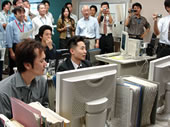 At 9:54 a.m. on September 27 (Japan Standard Time), the Micro-Lab Sat team started operations to terminate radio frequency links with the satellite. At 11:32 a.m., termination of radio frequency links was confirmed, and its mission operation was completed.
At 9:54 a.m. on September 27 (Japan Standard Time), the Micro-Lab Sat team started operations to terminate radio frequency links with the satellite. At 11:32 a.m., termination of radio frequency links was confirmed, and its mission operation was completed.
The Micro-Lab Sat was launched as a piggyback by the H-IIA Launch Vehicle No. 4 from the Tanegashima Space Center on Dec. 14, 2002, and its operation continued for three and half years, longer than its scheduled mission period.
By taking full advantage of the special features of the small satellite, easy handling and shorter development period, we were able to acquire precious experience such as using new technologies and nurturing young engineers. We will do our best to contribute to society by sharing our learning experience from the small satellite with the private sector.
September 23, 2006 Updated
M-V-7 successfully launched
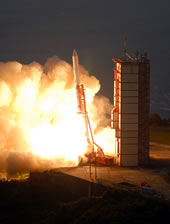 The Japan Aerospace Exploration Agency (JAXA) launched the M-V Launch Vehicle No. 7 (M-V-7) at 6:36 a.m. on September 23, 2006 (Japan Standard Time, JST) from the Uchinoura Space Center (USC).
The Japan Aerospace Exploration Agency (JAXA) launched the M-V Launch Vehicle No. 7 (M-V-7) at 6:36 a.m. on September 23, 2006 (Japan Standard Time, JST) from the Uchinoura Space Center (USC).
JAXA started receiving signals from the SOLAR-B at 7:21 a.m. (JST) at the Santiago Station, and from those signals we verified that the SOLAR-B had successfully separated from the launch vehicle and its solar array paddles (PDL) had been normally deployed.
The in-orbit SOLAR-B was given a nickname of "Hinode" (meaning "sunrise.")
September 22, 2006 Updated
Time set for launch of SOLAR-B/M-V-7
 The time for the SOLAR-B/M-V-7 launch scheduled on Sep. 23 (Sat) has been set at 6:36 a.m. (Japan Standard Time, JST.) The SOLAR-B aboard the M-V-7 is well prepared for launch as the launch rehearsal has been completed.
The time for the SOLAR-B/M-V-7 launch scheduled on Sep. 23 (Sat) has been set at 6:36 a.m. (Japan Standard Time, JST.) The SOLAR-B aboard the M-V-7 is well prepared for launch as the launch rehearsal has been completed.
The live broadcast of the SOLAR-B/M-V-7 launch is scheduled between 5:30 and 7:00 a.m. (JST) on the launch day.
September 21, 2006 Updated
SOLAR-B/M-V-7 Launch Rehearsal Completed
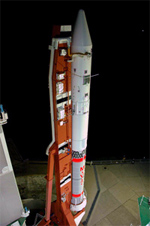 During the night of Sep. 19, a launch rehearsal was carried out following the actual launch process in the same way as on the launch day to confirm the schedule and operation of all equipment. At the pitch dark launch site, the launch assembly tower, which stores the launch vehicle, and the antennas were lit up, and the rehearsal was completed after the rocket launcher angle was set. The launch is scheduled for Sep. 23 (Sat), and the live broadcast of the SOLAR-B/M-V-7 launch is scheduled to start at 5:30 a.m.(JST) on the launch day.
During the night of Sep. 19, a launch rehearsal was carried out following the actual launch process in the same way as on the launch day to confirm the schedule and operation of all equipment. At the pitch dark launch site, the launch assembly tower, which stores the launch vehicle, and the antennas were lit up, and the rehearsal was completed after the rocket launcher angle was set. The launch is scheduled for Sep. 23 (Sat), and the live broadcast of the SOLAR-B/M-V-7 launch is scheduled to start at 5:30 a.m.(JST) on the launch day.
September 19, 2006 Updated
M-V-7 appears from the Launch Assembly Tower
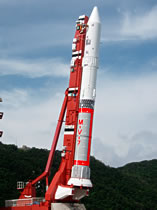 After completing the operational test for the launcher angle setting on Sep. 16, the M-V Launch Vehicle No.7, scheduled to be launched on September 23, 2006, came out from the Launch Assembly Tower. Launch preparations are progressing smoothly. Local people made and presented a thousand origami paper cranes praying for the success of the launch.
After completing the operational test for the launcher angle setting on Sep. 16, the M-V Launch Vehicle No.7, scheduled to be launched on September 23, 2006, came out from the Launch Assembly Tower. Launch preparations are progressing smoothly. Local people made and presented a thousand origami paper cranes praying for the success of the launch.
August 2006
August 28, 2006 Updated
AKARI unveils the birth and death of stars
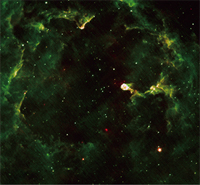 The JAXA infrared astronomical satellite "AKARI (formerly known as ASTRO-F)" was launched on February 21st, 2006 from Uchinoura Space Centre, Japan. AKARI is continuing its mission of surveying the entire sky, making a complete map of our cosmos in infrared light. Lately, AKARI has successfully acquired two new exciting images depicting scenes of the birth and death of stars.
The JAXA infrared astronomical satellite "AKARI (formerly known as ASTRO-F)" was launched on February 21st, 2006 from Uchinoura Space Centre, Japan. AKARI is continuing its mission of surveying the entire sky, making a complete map of our cosmos in infrared light. Lately, AKARI has successfully acquired two new exciting images depicting scenes of the birth and death of stars.
We were able to learn significant information about the star formation and death throes by the acquired images.
July 2006
July 26, 2006 Updated
Launch schedules for H-IIA F10 and M-V-7 set for September
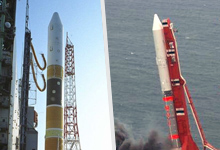 JAXA reported on July 26 the following two launch schedules to the Space Activities Commission.
JAXA reported on July 26 the following two launch schedules to the Space Activities Commission.
The H-IIA Launch Vehicle No. 10 (H-IIA F10) is scheduled to be launched from the Tanegashima Space Center on September 10, and the M-V Launch Vehicle No. 7 (M-V-7) is set to be launched from the Uchinoura Space Center on September 23.
June 2006
June 30, 2006 Updated
Prototype HTV unveiled to press at Tsukuba Space Center
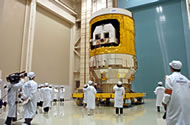 JAXA unveiled to the press a prototype of the "H-II Transfer Vehicle" (HTV), which transports goods to the International Space Station (ISS). The HTV is a cylindrical-shaped inter-orbital carrier whose length is 10 meters and diameter is 4.4 meters at the largest section. It can carry six tons of goods to the ISS. The prototype is manufactured for various environmental tests on the ground to check if it can bear with the temperature changes in space and acoustic and vibration environment at the time of the launch. The HTV is scheduled to be launched by the H-IIB launch vehicle, which is under development, in Japan Fiscal Year 2008.
JAXA unveiled to the press a prototype of the "H-II Transfer Vehicle" (HTV), which transports goods to the International Space Station (ISS). The HTV is a cylindrical-shaped inter-orbital carrier whose length is 10 meters and diameter is 4.4 meters at the largest section. It can carry six tons of goods to the ISS. The prototype is manufactured for various environmental tests on the ground to check if it can bear with the temperature changes in space and acoustic and vibration environment at the time of the launch. The HTV is scheduled to be launched by the H-IIB launch vehicle, which is under development, in Japan Fiscal Year 2008.
June 2, 2006 Updated
"Science" magazine features results of "Hayabusa" observations
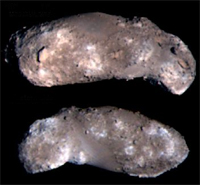 The asteroid probe "Hayabusa," which landed on the asteroid "Itokawa" last November, successfully turned on its ion engine, and it is now aiming to return to Earth in June 2010. The U.S. eminent scientific journal Science features the results of Hayabusa's scientific investigations in its June 2 edition. The "Hayabusa" observed Itokawa's shape, geographical features, reflectance, mineral composite, and gravity from an altitude of three to 20 km, and clarified the Itokawa's structure as a "pile of rubble." Science published seven Hayabusa-related essays, the first time for the magazine to feature a Japanese asteroid probe project. The Hayabusa project also received a "Space Pioneer Award" from the National Space Society of the United States at the International Space Development conference held in Los Angeles in May.
The asteroid probe "Hayabusa," which landed on the asteroid "Itokawa" last November, successfully turned on its ion engine, and it is now aiming to return to Earth in June 2010. The U.S. eminent scientific journal Science features the results of Hayabusa's scientific investigations in its June 2 edition. The "Hayabusa" observed Itokawa's shape, geographical features, reflectance, mineral composite, and gravity from an altitude of three to 20 km, and clarified the Itokawa's structure as a "pile of rubble." Science published seven Hayabusa-related essays, the first time for the magazine to feature a Japanese asteroid probe project. The Hayabusa project also received a "Space Pioneer Award" from the National Space Society of the United States at the International Space Development conference held in Los Angeles in May.
May 2006
May 28, 2006 Updated
"Daichi" observed earthquake stricken area in the central Java, Indonesia
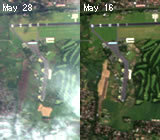 The Advanced Earth Observing Satellite "Daichi" (ALOS) observed central Java, the Republic of Indonesia, which was severely stricken by an earthquake on May 27, and the data has been provided to the International Charter "Space and Major Disaster" and the National Institute of Aeronautics and Space of Indonesia. (The images are the area near Yogyakarta airport before and after the earthquake.) The "Daichi" has been in a calibration phase to be ready for regular operations starting this October. It has been providing observation data, including the data on Mount Merapi, Indonesia, which had been showing signs of volcanic activity since the end of April and the flooded area in northern Thailand the other day, to related organizations.
The Advanced Earth Observing Satellite "Daichi" (ALOS) observed central Java, the Republic of Indonesia, which was severely stricken by an earthquake on May 27, and the data has been provided to the International Charter "Space and Major Disaster" and the National Institute of Aeronautics and Space of Indonesia. (The images are the area near Yogyakarta airport before and after the earthquake.) The "Daichi" has been in a calibration phase to be ready for regular operations starting this October. It has been providing observation data, including the data on Mount Merapi, Indonesia, which had been showing signs of volcanic activity since the end of April and the flooded area in northern Thailand the other day, to related organizations.
- Earthquake Stricken Area in central Java, Indonesia Observed by Advanced Land Observing Satellite "Daichi" (ALOS) (May 28, 2006)
- Flood in Northern Thailand Observed by Advanced Land Observing Satellite "Daichi" (ALOS) (May 25, 2006)
- Mount Merapi (Java, Indonesia) Observed by the Advanced Land Observing Satellite "Daichi" (Report #2) (May 16, 2006)
- Mount Merapi (Java, Indonesia) Observed by the Advanced Land Observing Satellite "Daichi" (April 29, 2006)
- Satellite Navigator
- Earth Observation Center
- Earth Observation Research Center
May 23, 2006 Updated
Commencement of "Akari" Observations
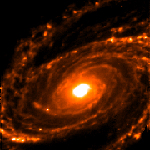 JAXA has confirmed the expected on-orbit performance of the infrared astronomical satellite "Akari"(ASTRO-F,) which was launched in February this year, during test observations, and started its regular operations. There is a telescope and two types of infrared observation equipment aboard the "Akari" for observing the entire sky spanning a large wavelength range from the near-infrared to the far-infrared. The test observations proved the drastic improvements in resolution compared to the conventional infrared observation satellites, thus we are expecting new infrared maps of the Universe by infrared rays and exciting discoveries in the evolution and origin of galaxies, stars, and planetary systems. (The image is the near-mid-infrared image of Spiral Galaxy M81.)
JAXA has confirmed the expected on-orbit performance of the infrared astronomical satellite "Akari"(ASTRO-F,) which was launched in February this year, during test observations, and started its regular operations. There is a telescope and two types of infrared observation equipment aboard the "Akari" for observing the entire sky spanning a large wavelength range from the near-infrared to the far-infrared. The test observations proved the drastic improvements in resolution compared to the conventional infrared observation satellites, thus we are expecting new infrared maps of the Universe by infrared rays and exciting discoveries in the evolution and origin of galaxies, stars, and planetary systems. (The image is the near-mid-infrared image of Spiral Galaxy M81.)
May 8, 2006 Updated
Astronaut Takao Doi selected to ride in Space Shuttle for second time
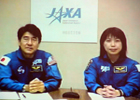 On May 5 (Eastern Daylight Saving Time), Minister Kosaka of the Japanese Ministry of Education, Culture, Sports, Science and Technology (MEXT) and NASA Administrator Griffin had a meeting in Washington DC, and selected Astronaut Takao Doi as a onboard crew member for the Space Shuttle mission for the first launch of the Japanese Experiment Module "Kibo" (the External Logistic Module Pressurized Section) to the International Space Station (ISS.) The launch is currently scheduled for the end of 2007. Astronaut Naoko Yamazaki was also selected as a crew support astronaut for the same mission.
On May 5 (Eastern Daylight Saving Time), Minister Kosaka of the Japanese Ministry of Education, Culture, Sports, Science and Technology (MEXT) and NASA Administrator Griffin had a meeting in Washington DC, and selected Astronaut Takao Doi as a onboard crew member for the Space Shuttle mission for the first launch of the Japanese Experiment Module "Kibo" (the External Logistic Module Pressurized Section) to the International Space Station (ISS.) The launch is currently scheduled for the end of 2007. Astronaut Naoko Yamazaki was also selected as a crew support astronaut for the same mission.
The crew support astronaut will assist Astronaut Doi throughout the training for the mission.
April 2006
April 29, 2006 Updated
Daichi's latest observation data on Mount Merapi, Indonesia
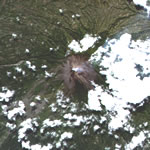 The Advanced Land Observing Satellite "Daichi," which was launched by the H-IIA launch vehicle in January 2006, made observations of Mount Merapi in Java, the Republic of Indonesia, on April 29 as it had shown signs of volcanic activity. The image data was also provided to the International Charter "Space and Major Disasters."
The Advanced Land Observing Satellite "Daichi," which was launched by the H-IIA launch vehicle in January 2006, made observations of Mount Merapi in Java, the Republic of Indonesia, on April 29 as it had shown signs of volcanic activity. The image data was also provided to the International Charter "Space and Major Disasters."
April 14, 2006 Updated
"Akari" ready for observations
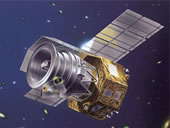 JAXA has been carefully carrying out initial operations of the first Japanese infrared astronomy satellite "Akari," which was launched on Feb. 22, after we were not able to use the two-dimensional solar sensor, which is part of the attitude control sensor. In the afternoon of April 14, JAXA successfully removed the cover (aperture lid) of the telescope, and that marked the completion of major post-launch initial events. Both the power generation and attitude of the satellite are stable, and the observation system is also working normally. Professor Hiroshi Murakami, the Project Manager, commented, "We are barely at the start line for observation operations. I hope that everybody is looking forward to the observation results." The first observation results will be released in mid May.
JAXA has been carefully carrying out initial operations of the first Japanese infrared astronomy satellite "Akari," which was launched on Feb. 22, after we were not able to use the two-dimensional solar sensor, which is part of the attitude control sensor. In the afternoon of April 14, JAXA successfully removed the cover (aperture lid) of the telescope, and that marked the completion of major post-launch initial events. Both the power generation and attitude of the satellite are stable, and the observation system is also working normally. Professor Hiroshi Murakami, the Project Manager, commented, "We are barely at the start line for observation operations. I hope that everybody is looking forward to the observation results." The first observation results will be released in mid May.
April 10, 2006 Updated
ETS-VIII: Deployment test of the reflector surface of the LDR
 |
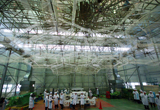 |
JAXA carried out a deployment test for the reflector surface of the Large-scale deployable antenna reflectors (LDR) of the Engineering Test Satellite (ETS-VIII) on April 7 in Tokyo. The ETS-VIII is scheduled to be launched in Japanese Fiscal Year 2006. The LDR is the largest deployable antenna in the world.
The ETS-VIII is equipped with two units of LDRs, and one unit composed of 14 modules, each of which is hexagonal like an umbrella.
The LDR will be neatly folded to about 1 meter in diameter and 4meters in length when it is loaded on top of the launch vehicle, but it is about 19 m * 17 m when deployed. Molybdenum and gold plated materials are used to reinforce the mesh reflector surface for lighter weight so that it can withstand in the harsh temperature changes in space. In addition cables are stitched for further support.
Photos:
Top: Reflectors being deployed
Bottom: Reflector surface of the LDR after deployment
March 2006
March 29, 2006 Updated
Japan-US Inquiry in Space Symposium
 The Japan-US Inquiry in Space Symposium, sponsored by the Ministry of Education Culture Sports, Science and Technology, was held on March 28th at the National Museum of Emerging Science and Innovation. While Professor Junichiro Kawaguchi reported the achievement and latest status of the Hayabusa, Dr. Louis Friedman, the executive director of the Planetary Society, lectured on the world history of space exploration and expressed his high expectations for Japanese space-related activities. In the subsequent discussion, various discussion topics for planetary exploration were presented including "international cooperation and competition in planetary exploration," "planetary exploration strategies that take advantages of Japanese strong points," and "how to overcome financial and other resource limits."
The Japan-US Inquiry in Space Symposium, sponsored by the Ministry of Education Culture Sports, Science and Technology, was held on March 28th at the National Museum of Emerging Science and Innovation. While Professor Junichiro Kawaguchi reported the achievement and latest status of the Hayabusa, Dr. Louis Friedman, the executive director of the Planetary Society, lectured on the world history of space exploration and expressed his high expectations for Japanese space-related activities. In the subsequent discussion, various discussion topics for planetary exploration were presented including "international cooperation and competition in planetary exploration," "planetary exploration strategies that take advantages of Japanese strong points," and "how to overcome financial and other resource limits."
In the course of the discussion, participants agreed with Dr. Friedman when he pointed out that "the biggest achievement of planetary exploration is that it inspires many people." A full report on the symposium will be published on our website at a later date.
Photo caption:
Dr. Friedman explaining the history of moon and planetary exploration.
March 27, 2006 Updated
Spring has come with cherry blossoms and lots of educational events at JAXA facilities
 The Japanese school spring vacation season has started, and each JAXA office has prepared various educational events. Between the 23rd and 25th, the Tanegashima Space Center (Kagoshima) conducted a "Space School" for high school to graduate school students. Participants could interact with space development and actually experienced launch control simulations and model rocket launches. At the Tsukuba Space Center, a "Cosmic College, Master Course" will be held from the 26th to the 28th of March. This is a first trial for JAXA to allow participants to experience and feel the "actual site of space development as a working place." Please try it.
The Japanese school spring vacation season has started, and each JAXA office has prepared various educational events. Between the 23rd and 25th, the Tanegashima Space Center (Kagoshima) conducted a "Space School" for high school to graduate school students. Participants could interact with space development and actually experienced launch control simulations and model rocket launches. At the Tsukuba Space Center, a "Cosmic College, Master Course" will be held from the 26th to the 28th of March. This is a first trial for JAXA to allow participants to experience and feel the "actual site of space development as a working place." Please try it.
March 22, 2006 Updated
Pay attention to JAXA i this week
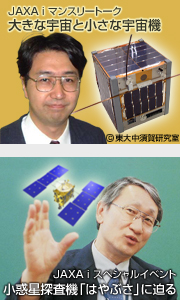 JAXA i, the JAXA information center in Marunouchi, Tokyo, will hold a special event for the spring vacation season in addition to our regular monthly event.
JAXA i, the JAXA information center in Marunouchi, Tokyo, will hold a special event for the spring vacation season in addition to our regular monthly event.
<JAXA i monthly talk>
Every month, JAXA i invites a specialist in the fields of space and aviation for a small talk. This month's speaker is Professor Nakasuga of the University of Tokyo, who is in charge of a micro satellite project.
<JAXA i spring vacation event in Marunouchi OAZO>
We will hold a special event for the asteroid probe "Hayabusa" at the OO square on the first floor of the Marunouch OAZO building on March 26, the first Sunday of the Japanese school spring vacation period. The event includes a talk show by the Hayabusa project manager, Junichiro, Kawaguchi, and live performance by the grand prix winner of the Space Music Campaign held last year. For more details, please check the "VISIT JAXA - JAXA i -" site.
March 8, 2006 Updated
Three MS certified astronauts held a press conference
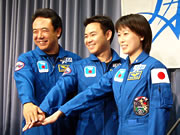 The three JAXA astronauts who were certified as Mission Specialists (MS) by NASA held a press conference at the JAXA Tokyo office. They are Astronaut Satoshi Furukawa, Akihiko Hoshide, and Naoko Yamazaki. The three astronauts who have gone through various types of stringent training talked about their hopes and expectations to contribute to the assembly of the International Space Station/Kibo and manned Moon and Mars exploration, as well as their enthusiasm about their space trip and further training.
The three JAXA astronauts who were certified as Mission Specialists (MS) by NASA held a press conference at the JAXA Tokyo office. They are Astronaut Satoshi Furukawa, Akihiko Hoshide, and Naoko Yamazaki. The three astronauts who have gone through various types of stringent training talked about their hopes and expectations to contribute to the assembly of the International Space Station/Kibo and manned Moon and Mars exploration, as well as their enthusiasm about their space trip and further training.
March 8, 2006 Updated
Communication with the Hayabusa restored Trajectory was successfully estimated on Mar. 6 for the first time in three months
 Communication with the asteroid probe "Hayabusa" has been restored, though it is through a low speed of 32 bps. The Hayabusa's communication with the earth had been lost since November 2005 as the attitude of the spacecraft swayed off course after taking off from the small asteroid "Itokawa."
Communication with the asteroid probe "Hayabusa" has been restored, though it is through a low speed of 32 bps. The Hayabusa's communication with the earth had been lost since November 2005 as the attitude of the spacecraft swayed off course after taking off from the small asteroid "Itokawa."
We have been gradually finding out the current status of the Hayabusa, and, on March 6, we were able to estimate its current position and speed for the first time in three months. The operation team will continue their efforts to have it back to earth by June 2010.
March 1, 2006 Updated
Japan-U.S. Inquiry in Space Symposium to be held at the National Museum of Emerging Science and Innovation
 The Japan U.S Inquiry in Space Symposium will be held at the National Museum of Emerging Science and Innovation (Odaiba, Tokyo) on March 28 to discuss the dreams and future of space exploration with Dr. Louis Friedman of the Planetary Society (distinguished guest) and Dr. Junichiro Kawaguchi of the "Hayabusa." Other panelists include Mr. Hiroki Matsuo of the Space Activities Commission, Dr. Sho Sasaki of the National Astronomical Observatory of Japan, and Mr. Shinya Matsuura, a non-fiction writer. Dr. Yasunori Matogawa, JAXA Associate Executive Director, will act as MC.
The Japan U.S Inquiry in Space Symposium will be held at the National Museum of Emerging Science and Innovation (Odaiba, Tokyo) on March 28 to discuss the dreams and future of space exploration with Dr. Louis Friedman of the Planetary Society (distinguished guest) and Dr. Junichiro Kawaguchi of the "Hayabusa." Other panelists include Mr. Hiroki Matsuo of the Space Activities Commission, Dr. Sho Sasaki of the National Astronomical Observatory of Japan, and Mr. Shinya Matsuura, a non-fiction writer. Dr. Yasunori Matogawa, JAXA Associate Executive Director, will act as MC.
Admission is free, but prior registration through the Internet or fax is required.
The Symposium is sponsored by the Ministry of Education, Culture, Sports, Science and Technology.
February 2006
February 27, 2006 Updated
JAXA acquired image data on disaster-hit Leyte Island through the "Daichi"
 JAXA took and analyzed image data on Leyte Island, where a huge landslide occurred, through the Phased Array type L-band Synthetic Aperture Radar (PALSAR) aboard the Advanced Earth Observing Satellite "Daichi." We have provided the data to the International Charter "Space and Major Disasters" and the Asian Disaster Reduction Center (ADRC).
JAXA took and analyzed image data on Leyte Island, where a huge landslide occurred, through the Phased Array type L-band Synthetic Aperture Radar (PALSAR) aboard the Advanced Earth Observing Satellite "Daichi." We have provided the data to the International Charter "Space and Major Disasters" and the Asian Disaster Reduction Center (ADRC).
February 22, 2006 Updated
ASTRO-F/M-V-8 successfully launched
Nickname is "Akari"
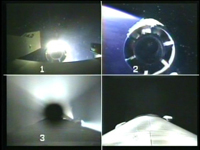 JAXA launched the 21st Scientific Satellite (ASTRO-F) aboard the M-V Launch Vehicle No. 8 (M-V-8) at 6:28 a.m. on February 22, 2006 (Japan Standard Time, JST) from the Uchinoura Space Center (USC).
JAXA launched the 21st Scientific Satellite (ASTRO-F) aboard the M-V Launch Vehicle No. 8 (M-V-8) at 6:28 a.m. on February 22, 2006 (Japan Standard Time, JST) from the Uchinoura Space Center (USC).
The launch vehicle flew smoothly, and it was confirmed that the satellite was safely injected into its scheduled orbit.
The in-orbit ASTRO-F was given a nickname of "Akari" (meaning a "light.")
We would like to express our appreciation for the cooperation and support from all related organizations and people who helped contribute to the successful launch of the ASTRO-F/M-V-8.
February 21, 2006 Updated
ASTRO-F/M-V-8 launch postponed
The new launch day is the 22nd
JAXA announced that the launch of the 21st Scientific Satellite, ASTRO-F, by the M-V Launch Vehicle No. 8 (M-V-8) was postponed due to the adverse weather conditions.
The launch was originally scheduled on February 21 (JST). The new launch date and time are at 6:28 a.m. on February 22 (Wed.)
February 20, 2006 Updated
ASFTRO-F/M-V-8 launch set for tomorrow
 While preparing for the launch tomorrow, the ASTRO-F/M-V-8 underwent a simplified operational checkup on Feb. 18. Preparations are progressing smoothly.
While preparing for the launch tomorrow, the ASTRO-F/M-V-8 underwent a simplified operational checkup on Feb. 18. Preparations are progressing smoothly.
The launch time is set at 6:28 on February 21 (Tue,) and the final terminal time schedule will start in the evening of the 20th. The live launch report will start one hour prior to the launch.
Photo: Operational Checkup on the 10th at Uchinoura
February 18, 2006 Updated
MTSAT-2/H-IIA F9 launch successful
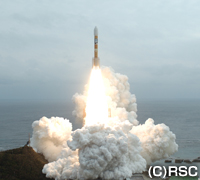 Rocket System Corporation (RSC) and the JAXA launched the Multi-functional Transport Satellite 2 (MTSAT-2) aboard the H-IIA Launch Vehicle No. 9 (H-IIA F9) at 3:27 p.m. on February 18, 2006 (Japan Standard Time, JST) from the Tanegashima Space Center.
Rocket System Corporation (RSC) and the JAXA launched the Multi-functional Transport Satellite 2 (MTSAT-2) aboard the H-IIA Launch Vehicle No. 9 (H-IIA F9) at 3:27 p.m. on February 18, 2006 (Japan Standard Time, JST) from the Tanegashima Space Center.
The launch vehicle flew smoothly, and, at about 28 minutes and 11 seconds after liftoff, the separation and injection of the MTSAT-2 into a Geostationary transfer orbit were confirmed.
We would like to express our profound appreciation for the cooperation and support of all related personnel and organizations that helped contribute to the successful launch of the MTSAT-2 aboard the H-IIA F9.
* Launch operations for the H-IIA F9 are commissioned by Rocket System Corporation.
*The MTSAT-2 is owned by the Civil Aviation Bureau and the Japan Meteorological Agency, which fall under the Ministry of Land, Infrastructure and Transport.
February 17, 2006 Updated
Unprecedented consecutive launches in Japan with H-IIA and M-V
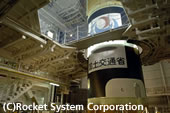 |
 |
The H-IIA F9 launch with the MTSAT-2 onboard is fast approaching. It is scheduled for Feb. 18 (Sat.) Only three days after the H-IIA launch, the M-V F8 with the infrared astronomical satellite, ASTRO-F, aboard, is scheduled to be launched on Feb. 21 (Tue.) Preparations for both launch vehicles are smoothly underway. * Launch operations for the H-IIA F9 are commissioned by Rocket System Corporation.
The MTSAT-2 is owned by the Civil Aviation Bureau and the Japan Meteorological Agency, which fall under the Ministry of Land, Infrastructure and Transport.
February 17, 2006 Updated
Mt. Fuji and Shizuoka City during the night and Tanegashima observed by visible to infrared lights
First images acquired by the PALSAR and AVNIR-2 of the "Daichi"
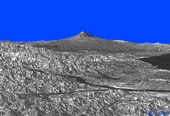 |
 |
JAXA released the images of Mt. Fuji and Shizuoka City observed during the night by the Phased Array type L-band Synthetic Aperture Radar (PALSAR) and the image of Tanegahima by the Advanced Visible and Near Infrared Radiometer type-2 (AVNIR-2). Both sensors are aboard the Advanced Land Observing Satellite “Daichi.” The Daichi is the only satellite that can perform high resolution observations of one specific area with both light and radio frequency by using the two sensors.
For high resolution images, please check the press releases.
* The PALSAR was developed by the Ministry of Economy, Trade, and Industry in cooperation with JAXA.
February 15, 2006 Updated
Mt. Fuji and Shimizu Port are clear in the first image data from the "Daichi"
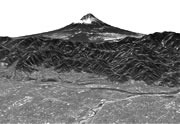 Image data has been acquired by the Panchromatic Remote-sensing Instrument of Stereo Mapping (PRISM) onboard the Advanced Land Observing Satellite "Daichi." The clear 3-D image of Mt. Fuji and the detailed image of the Shimizu Port area prove the high performance of the sensor.
Image data has been acquired by the Panchromatic Remote-sensing Instrument of Stereo Mapping (PRISM) onboard the Advanced Land Observing Satellite "Daichi." The clear 3-D image of Mt. Fuji and the detailed image of the Shimizu Port area prove the high performance of the sensor.
February 13, 2006 Updated
Two satellites mated with launch vehicles
 |
 |
Two satellites that will be launched from Tanegashima and Uchinoura respectively have been smoothly undergoing preparations for launch.
For further updates, please check the countdown page (click the above banner.)
Photos:
(Left) The fairing loaded onto the H-IIA F9* (Feb. 10, in Tanegashima)
(Right) The angle of the launcher fixed for M-V F8 (in the evening of Feb 10, in Uchinoura)
(*The H-IIA F9 launch is commissioned by Rocket System Corporation.)
February 7, 2006 Updated
Launch operations progressing smoothly
 The preparation of two satellites that will be launched from Tanegashima and Uchinoura, respectively, are being carried out on schedule. Please refer to the Countdown sites (from the banners above) for the latest information.
The preparation of two satellites that will be launched from Tanegashima and Uchinoura, respectively, are being carried out on schedule. Please refer to the Countdown sites (from the banners above) for the latest information.
Photo: The nose fairing assembly for the ASTRO-F/M-V-8 (Feb. 6)
February 1, 2006 Updated
Two consecutive launch schedules on February 18 (Tanegashima) and 21 (Uchinoura)
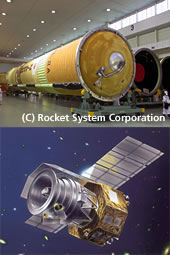 Today, JAXA reported the following two launch schedules to the Space Activities Commission.
Today, JAXA reported the following two launch schedules to the Space Activities Commission.
- From 3:26 thru 4:44 p.m. on February 18 (Wed), 2006 (Japan Standard Time, JST): Multi-functional Transport Satellite-2 (MTSAT-2) by H-IIA Launch Vehicle No. 9
(The launch site operations (mainly the operations starting four days
prior to the launch day) are commissioned to JAXA by Rocket System
Corporation)
- From 6:00 thru 7:00 a.m. on February 21, 2006 (JST): Infrared Astronomical Satellite "ASTRO-F" by M-V Launch Vehicle No. 8
January 2006
January 28, 2006 Updated
Daichi (ALOS) completes critical phase
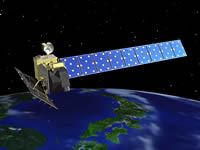 As previously announced, the Daichi had put itself into safety mode because of the anomaly detection. We carried out operations to have the Daichi return to normal operations, and verified that all function of the satellite are working normally. JAXA then decided to complete the critical phase at 5:00 p.m. on Janunry 28 (JST) and moved onto the initial functional verification phase.
As previously announced, the Daichi had put itself into safety mode because of the anomaly detection. We carried out operations to have the Daichi return to normal operations, and verified that all function of the satellite are working normally. JAXA then decided to complete the critical phase at 5:00 p.m. on Janunry 28 (JST) and moved onto the initial functional verification phase.
January 28, 2006 Updated
The critical phase of Daichi extended
At 10:51 p,m. on the 27th (JST), an anomaly detection function was activated for the data processing system and Daichi consequently put itself into safety mode.
We are currently investigating the status and cause, but other conditions such as the atttitude of the Daichi is stable.
To investigate the cause, we decided to continue the critical phase of Daichi and take all possible measures to return to normal operations.
January 26, 2006 Updated
Deployment of the Antenna for the Phased Array Type L-band Synthetic Aperture Radar (PALSAR)
 The Japan Aerospace Exploration Agency (JAXA) started the deployment of the Antenna for the Phased Array Type L-band Synthetic Aperture Radar (PALSAR) from 10:23 a.m.(Japan Standard Time, JST), and confirmed that it had been successfully completed through telemetry data received at 12:09 p.m.(JST.)
The Japan Aerospace Exploration Agency (JAXA) started the deployment of the Antenna for the Phased Array Type L-band Synthetic Aperture Radar (PALSAR) from 10:23 a.m.(Japan Standard Time, JST), and confirmed that it had been successfully completed through telemetry data received at 12:09 p.m.(JST.)
All deployments of paddle and antennas of "Daichi"(ALOS) had been successfully completed.
The satellite is in a stable condition.
January 25, 2006 Updated
Deployment of the Data Relay Satellite Communication Antenna (DRC) for the Advanced Land Observing Satellite "Daichi" (ALOS)
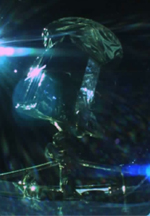 The Japan Aerospace Exploration Agency (JAXA) started the deployment of the Data Relay Satellite Communication Antenna (DRC) of the Daichi from 9:37 a.m., January 25 (Japan Standard Time, JST), and confirmed that it had been successfully completed through telemetry data received at 9:44 a.m. January 25 (JST).
The Japan Aerospace Exploration Agency (JAXA) started the deployment of the Data Relay Satellite Communication Antenna (DRC) of the Daichi from 9:37 a.m., January 25 (Japan Standard Time, JST), and confirmed that it had been successfully completed through telemetry data received at 9:44 a.m. January 25 (JST).
The satellite is in a stable condition.
January 24, 2006 Updated
Launch Result of "Daichi" (ALOS) / H-IIA F8
 The H-IIA Launch Vehicle No. 8 (H-IIA F8) with the Advanced Land Observing Satellite "Daichi"(ALOS) onboard was launched at 10:33 a.m. on January 24, 2006 (Japan Standard Time, JST.) The launch vehicle flew smoothly, and, at 16 minutes and 30 seconds after liftoff, the Daichi separation was confirmed.
The H-IIA Launch Vehicle No. 8 (H-IIA F8) with the Advanced Land Observing Satellite "Daichi"(ALOS) onboard was launched at 10:33 a.m. on January 24, 2006 (Japan Standard Time, JST.) The launch vehicle flew smoothly, and, at 16 minutes and 30 seconds after liftoff, the Daichi separation was confirmed.
The Perth first mobile station in Australia started receiving signals from the ALOS at 10:52 a.m. (JST), and by those signals, JAXA confirmed that the solar array paddle deployment was successfully completed.
January 23, 2006 Updated
Launch Postponement of the Daichi
The launch of the H-IIA Launch Vehicle No. 8 (H-IIA F8) with the Advanced Land Observing Satellite "Daichi" (ALOS) onboard has been postponed after JAXA took some extra time to investigate a malfunction discovered in one of the ground facilities which monitors the temperature of the air conditioner for the payload fairing during countdown operations.
The new launch date has been set for January 24 (Tue), 2006 (Japan Standard Time, JST).
The scheduled launch time is between 10:33 thru 10:43 a.m. (JST.)
The launch was previously scheduled for January 23 (Mon), 2006 (JST.)
January 23, 2006 Updated
January 21, 2006 Updated
The new launch day is January 23.
The scheduled launch time is between 10:33 thru 10:43 a.m. (JST) on January 23, 2006.
January 20, 2006 Updated
JAXA will not carry out the launch of the H-IIA F8 on the 22nd
JAXA has decided that we will not carry out the launch on January 22.
The new launch day will be announced two days prior to the launch.
January 19, 2006 Updated
Launch of the H-IIA F8 will be no earlier than January 22
JAXA has decided that we will not carry out the launch until January 21.
The new launch day will be announced two days prior to the launch.
January 18, 2006 Updated
Launch Delay of the H-IIA F8
The launch of the H-IIA Launch Vehicle No. 8 (H-IIA F8) with the Advanced Land Observing Satellite Daichi (ALOS) onboard has been postponed due to a malfunction found yesterday in a part of the launch vehicle onboard equipment. We will replace the malfunctioned part with a new one.
The launch was originally scheduled on January 19 (Thu), 2006 (Japan Standard Time) from the Tanegashima Space Center.
January 13, 2006 Updated
Live Broadcast of H-IIA Launch Vehicle No.8 (H-IIA F8) Launch
 In the OO Square, you can enjoy powerful images created by Nikkei digital multi vision.
In the OO Square, you can enjoy powerful images created by Nikkei digital multi vision.
JAXA i will broadcast live the launch of the Advanced Land Observing Satellite (ALOS) by the H-IIA Launch Vehicle No.8 (H-IIA F8) under the following schedule.
Launch day : January 19 (Thu)
Live broadcast : from 9:55 to 10:55
Launch time : 10:33 to 10:43
Location : OO Square and JAXA i
The launch date and time are subject to change due to adverse weather and other reasons.
*We would like to thank Nikkei Notio for its cooperation in the use of the Nikkei digital multi vision.
